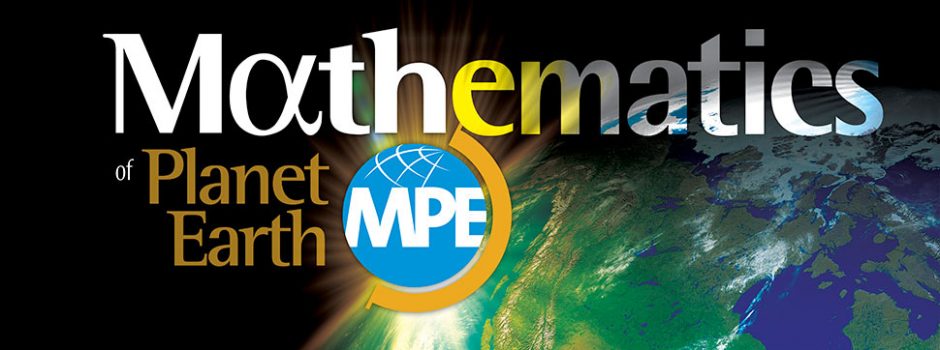Search
-
Recent Blogs
- What is MPE? April 22, 2020
- April 22, 2020 — 50 years of Earth Day April 17, 2020
- Major Website Constructors Reviews! | Create Your Own Website April 2, 2019
Professor Christopher K.R.T. Jones — Recipient of the 2020 MPE Prize

Professor Chris Jones is the Bill Guthridge Distinguished Professor in Mathematics at the University of North Carolina at Chapel Hill and Director of the Mathematics and Climate Research Network (MCRN). The 2020 MPE Prize recognizes Professor Jones for his many significant contributions to climate science and the mathematics of planet Earth.Categories
MPE2013 Newsletter
Category Archives: Geophysics
How Inge Lehmann discovered the inner core of the Earth
Inge Lehmann was a Danish mathematician. She worked at the Danish Geodetic Institute, and she had access to the data recorded at seismic stations around the world. She discovered the inner core of the Earth in 1936, by analyzing the seismic data from large earthquakes recorded at different stations around the world. Continue reading
Posted in Geophysics
Leave a comment
Paleo-Structure Modeling of the Earth’s Mantle
 Paleo-structure modeling of the Earth’s mantle will provide crucial information on the history of plate-driven forces, the material properties of the deep Earth, the temporal evolution of the core-mantle boundary. Continue reading
Paleo-structure modeling of the Earth’s mantle will provide crucial information on the history of plate-driven forces, the material properties of the deep Earth, the temporal evolution of the core-mantle boundary. Continue reading
Posted in Geophysics
Leave a comment
Mathematics Can Improve Seismic Risk Protection
Mathematical and numerical modeling can be used to better understand the physics of earthquakes, improve the design of site-specific structures and facilities, and enhance seismic-risk maps. Continue reading
Posted in Geophysics, Natural Disasters
Leave a comment
SAMSI Workshop – Dynamics of Seismicity, Earthquake Clustering and Patterns in Fault Networks
Despite considerable research, earthquake dynamics remains one of the major challenges in geophysics. A recent workshop on Dynamics of Seismicity, Earthquake Clustering and Patterns in Fault Networks at SAMSI in Research Triangle Park, North Carolina, was organized to achieve progress in this field. Continue reading
Posted in Geophysics, Statistics, Workshop Report
Leave a comment
AGU Science Policy Conference, Washington, DC, June 24-26
The American Geophysical Union held its 2nd Annual Science Policy Conference in the Walter E. Washington Convention Center in Washington, DC, June 24-26. Continue reading
Posted in Climate Change, Conference Report, Geophysics
Leave a comment
What Does Altitude Mean?
If we take a simple model of the surface of the Earth to be a sphere of radius $R$, then the altitude of a point is its distance to the center of the Earth minus $R$. But we know that the surface of the Earth is not exactly a sphere Continue reading
Posted in Geophysics, Mathematics
Leave a comment
DIMACS/CCICADA Collaboration on REU and Other Sustainability Projects
The Center for Discrete Mathematics and Theoretical Computer Science (DIMACS) and the Command Control Interoperability Center for Advanced Data Analysis (CCICADA), both based at Rutgers University, have collaborated on some recent activities to enhance the summer experience for several undergraduate students participating in the DIMACS/CCICADA Research Experiences for Undergraduates (REU) program. DIMACS and CCICADA recently co-hosted a workshop on Science and Technology Innovations in Hurricane Sandy Research. Continue reading
Posted in Astrophysics, Atmosphere, Biodiversity, Biogeochemistry, Biology, Biosphere, Carbon Cycle, Climate, Climate Change, Climate Modeling, Climate System, Complex Systems, Computational Science, Conference, Conference Announcement, Conference Report, Cryosphere, Data, Data Assimilation, Data Visualization, Dimension Reduction, Disease Modeling, Dynamical Systems, Ecology, Economics, Energy, Epidemiology, Evolution, Extreme Events, Finance, General, Geophysics, Imaging, Inverse Problems, Machine Learning, Mathematics, Meteorology, Natural Disasters, Networks, Ocean, Optimization, Paleoclimate, Patterns, Political Systems, Probability, Public Event, Public Health, Renewable Energy, Resource Management, Risk Analysis, Social Systems, Statistics, Sustainability, Sustainable Development, Tipping Phenomena, Transportation, Uncertainty Quantification, Weather, Workshop Announcement, Workshop Report
Leave a comment
2013 SIAM Conference on Mathematical and Computational Issues in the Geosciences
The 2013 SIAM Conference on Mathematical and Computational Issues in the Geosciences will be held in Padua, Italy, June 17-20. Continue reading
Posted in Conference Announcement, Geophysics
Leave a comment
Discontinuous Pressure in Coupled Flows
Pressure is an important property of fluid flow, and it is known that the pressure changes continuously in the fluid domain. In the coupling of flows of different nature, however, the situation can be more complicated and discontinuities may appear in the pressure field. Continue reading
Posted in Geophysics, Mathematics
Leave a comment
Why do earthquakes change the speed of rotation of the Earth?
MPE2013 gives us an opportunity to learn more about our planet. There are interesting features to be explored that require simple but deep principles of physics and that can become the basis of a discussion in the classroom. Continue reading
Posted in Geophysics, Natural Disasters
Leave a comment
Flow through heterogeneous porous rocks: What average is the correct average?
How fast does water flow through sand or soil? Maybe not so fast, but everyone has seen water soak into beach sand and garden soils. Most people have also noticed a concrete sidewalk soaking up a little water as rain begins to come down. But how fast does water flow through a rock? Continue reading
Posted in Geophysics, Mathematics
Leave a comment
Some universality in fractal sea coasts?
Sandy coasts have a smooth profile while rocky coasts have a fractal nature. One characteristic feature of a rocky coast is that new details appear when we zoom in on it. And if we were to measure the length of the coast, the length would increase significantly when zooming in on the details. Continue reading
Posted in Geophysics, Ocean
Leave a comment
Mathematicians listen as the Earth rumbles…
“Mathematicians listen as the Earth rumbles… ” was the title of the fourth MPE Simons Lecture given by Ingrid Daubechies in Montreal on April 10. Her splendid lecture was delivered in French, but both English and French videos of the lecture will be on display soon on the Simons website. Continue reading
Posted in General, Geophysics, Imaging, Mathematics
Leave a comment
The Great Wave Explained by Directional Focusing
One of the most famous images in Japanese art is the Great Wave off Kanagawa, a woodblock print by the Japanese artist Hokusai. The print is also famous in mathematics: the structure of the breaking wave at its crest illustrates features of self-similarity, and the large amplitude of the wave has led it to be interpreted as a rogue wave generated from nonlinear wave effects. Continue reading
Posted in Geophysics, Ocean
Leave a comment
Modeling and Prediction of Earthquakes
March 11 marks the second anniversary of the 2011 9.0 earthquake with epicenter located off the coast of Japan, which caught the world—including expert seismologists—by surprise. It was a stark reminder of how much is still unknown about faults and their sudden, catastrophic, behavior. Continue reading
Posted in Geophysics
Leave a comment
Nonlinear Waves and the Growth of a Tsunami
This past week at AIM Mark Ablowitz told me about an interesting article (with beautiful pictures) he wrote with Douglas Baldwin called “Nonlinear shallow ocean-wave silicon interactions on flat beaches.” The propagation of these waves may contribute to the growth of tsunami waves. Continue reading
Posted in Geophysics, Ocean
2 Comments
There Will Always be a Gulf Stream — An Exercise in Singular Perturbation Technique
One hears occasionally in the popular media that one possible consequence of global warming might be the disappearance of the Gulf Stream. This makes physical oceanographers cringe. The Gulf Stream and its analogs in other ocean basins exist for fundamental physical reasons. Climate change may well bring changes in the Gulf Stream. It may not be in the same place, may not be of the same strength or have the same temperature and salinity characteristics, but as long as the continents bound the great ocean basins, the sun shines, the earth turns toward the east and the wind blows in response, there will be a Gulf Stream. Continue reading
Posted in Geophysics, Mathematics, Ocean
Leave a comment
Stochastics in Geophysical Fluid Dynamics
A workshop is taking place this week at the American Institute of Mathematics (AIM) in Palo Alto, California, on “Stochastics in Geophysical Fluid Dynamics: Mathematical foundations and physical underpinnings.” This workshop is co-organized by Nathan Glatt-Holtz (Institute of Mathematics and … Continue reading
Posted in Geophysics, Mathematics
Leave a comment
Ice Floes, Coriolis Acceleration and Estimating the Viscosity of Air and Water
I have wanted to run this story down since I saw the reference in Lamb’s Hydrodynamics to a paper by G. I. Taylor that contains a description of what oceanic and atmospheric scientists call “Ekman layers.” Physical oceanographers learn early … Continue reading
Posted in Atmosphere, Geophysics, Mathematics, Ocean
Leave a comment
How Old Is the Earth?
The fascinating history of the attempts of calculating the age of the Earth from the gradient of temperature inside the crust and mantle goes back to the 19th century, in parallel with the development of geology, the theory of evolution, and the discovery of radioactivity. Continue reading
Posted in Geophysics
Leave a comment




